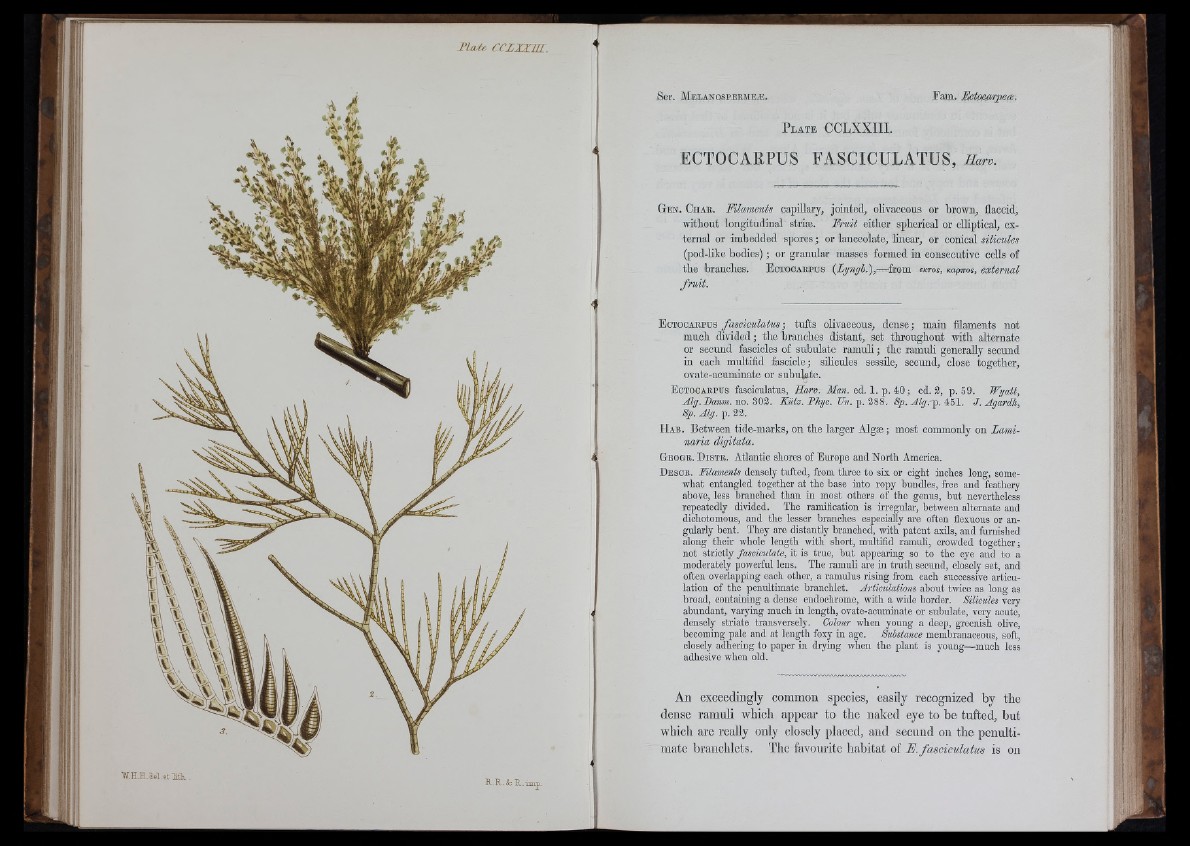
F ia t e CCIIXm.
Ii
A ... *^11*
a.R.fci,. xaip.
P l a t e CCLXXIII.
ECTOCARPUS FASCICULATUS, llarv.
G en . O h a r. Filaments capillary, jo in te d , olivaceous or b row n , flaccid,
w ith o u t lo n g itu d in a l striæ . F ru it e ith e r sp h erica l or elliptic a l, exte
rn a l o r im b ed d ed spores ; or lanc eola te , lin e a r, o r conical silicules
(pod-like bodies) ; o r g ra n u la r masses fo rm ed in co n se cu tiv e cells of
th e b ra n ch es . E ctocarpus ( i y » y i . ) ,— from enTor, sapnos, external
E c to c a r p u s fa sc ic u la tu s ; tu fts olivaceous, d e n s e ; m a in fllaments n o t
m u c h d iv id e d ; th e b ran ch es d is ta n t, s e t th ro u g h o u t w ith a lte rn a te
or se c u n d fascicles o f su b u la te r am u l i ; th e ram u li g enerally s ecu n d
in each m u ltifld fa s c ic le ; silicules sessile, s ecund, close to g e th e r,
o v a te -a cum in a te or su b u late.
E ctocarpus fasciculatus, Harv. J f « . ed. 1. p. 40 ; ed. 2, p. 59.
Yfy. Darem. no. 302. Kiitz. Phyc. Un.-ÿ.^ZZ. Sp. Alg.-ç. i h l . J. Agardh,
Sp. Alg. p. 33.
U a b . Between tide-marks, on the larger Algæ ; most commonly on Lami-
naria digitata.
Geogr. D is t r . Atlantic shores of Europe and North America.
D e scr. Mlaments densely tufted, from three to six or eight iuches long, somewhat
entangled together at the base into ropy bundles, free and feathery
above, less branched than in most others of the genus, but nevertheless
repeatedly divided. The ramification is irregular, between alternate and
dichotomous, and the lesser branches especially are often flexuous or angularly
bent. They are distantly branched, with patent axUs, and fiunished
along their whole length with short, multifid ramuli, crowded together ;
not strictly fasciculate, it is true, but appearing so to the eye and to a
moderately powerful lens. The ramuli are in truth secund, closely set, and
often overlapping each other, a ramulus rising from each successive articulation
of the penultimate branchlet. Articulations about twice as long as
broad, containing a dense endochrome, with a wide border. Silicules very
abundant, varying much in length, ovate-acuminate or subulate, very acute,
densely striate transversely. Colour when young a deep, greenish olive,
becoming pale and at length foxy in age. Substance memhrauaceous, soft,
closely adhering to paper in drying when the plant is young—much less
adhesive when old.
An exceedingly common species, easily recognized by the
dense ramuli which appear to the naked eye to be tufted, but
which are really only closely placed, and secund on the penultimate
branchlets. The favourite habitat of F. fasciculatus is on